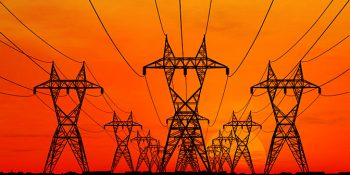
A team of researchers in the U.S. and Europe, including key contributors from Colorado State University, is poised to globally integrate electrical grids in a way that resonates with the creation of the internet more than 50 years ago.
On Sept. 26, the researchers will convene at Idaho National Laboratory for a live demonstration of the Real-Time Super Lab concept, which shows how electricity can be rerouted across vast distances to address disruptions. The team envisions that large-scale blackouts can be prevented by moving electricity intercontinentally, the same way utilities currently do regionally, but at a much larger scale.
Joining the Real-Time Super Lab effort is a CSU team led by Siddharth “Sid” Suryanarayanan, associate professor and Rhoden Professor in the Department of Electrical and Computer Engineering. His team includes Fathalla Eldali, a Ph.D. student who commands the CSU-based linkup to Idaho National Lab, and software engineer Jerry Duggan, who critically helped the team establish the high-speed connection between the two campuses.
Involved since the project’s inception in 2015, the CSU team has modeled the electrical grid’s distribution side, which is the portion closest to the end user. Their contribution is the development of sophisticated models on a digital simulator that perform real-time computations to mimic the actual U.S. power system.
“The goal of this demonstration is to find methods and techniques for creating the next-generation electric power system that’s resilient against cyber and physical attacks, whether manmade or natural,” Suryanarayanan said. “The driving principle is that we are pooling our resources, whether that be computers or human capital, in solving this problem, rather than establishing ourselves in just one location.”
Global interactions, reduced costs
Such global interaction can prepare America for future power system challenges, reduce the cost of outages, and make electrical power grids more resilient.
The efforts build on work by the U.S. Department of Energy’s Idaho National Lab and the National Renewable Energy Laboratory. Researchers at Sandia National Laboratory and five universities, two of them in Europe, have joined Idaho National Lab to explore the idea that electrons can be sent around the world in the same manner as digital packets of 0s and 1s over the internet.
“This is more than computers talking to each other,” said Rob Hovsapian, Idaho National Laboratory’s Power and Energy Systems department manager. “We are developing capabilities for geographically distributed real-time grid simulation with shared assets at [Idaho National Laboratory], other national labs, universities and utilities.”
In 2015, Idaho National Laboratory and National Renewable Energy Laboratory successfully demonstrated the capability to connect grid simulations at their two labs for real-time interaction over the internet. Both the Idaho lab’s Power and Energy Real-Time Laboratory and National Renewable Energy Laboratory’s Energy Systems Integration Facility can merge computer-based simulations of the power grid with actual hardware, including wind turbines, solar inverters, batteries and electric vehicles. This is a capability called “power hardware in the loop.”
The two national laboratories were able to connect their Digital Real-Time Simulators and achieve grid simulation. This allowed hardware or software at one lab to directly interact with hardware or software at the other lab.
Eight partners
Leveraging assets and expertise at other national labs and academic institutions, the Real-Time Super Lab concept brings more assets into the mix, with the following participants contributing specific capabilities:
- Sandia National Laboratory’s photovoltaic test bed
- Colorado State University’s high-performance computer-based energy management system (Suryanarayanan’s team)
- Washington State University’s Microgrid Laboratory
- University of South Carolina’s power electronics and distribution research
- RWTH Aachen University’s co-simulation framework
- Polytechnic University of Turin’s high-performance computer-based Energy Management System
- National Renewable Energy Laboratory’s Energy Systems Integration Facility
- Idaho National Laboratory’s Power and Energy Real-Time Laboratory
[Idaho National Laboratory] and [National Renewable Energy Laboratory] research made the project possible by addressing data latency issues and improving available bandwidth. — CSU Ph.D. graduate Manish Mohanpurkar, the Idaho lab’s Power and Energy Systems group lead, who began working on concepts related to the Real-Time Super Lab as a student in Suryanarayanan’s lab several years ago.
The Wide Area Network demonstrations that took place between the two national labs showed that most data packets took less than 17 milliseconds to travel from point to point. To mitigate data latency issues – like those that create cell phone echoes and delays – researchers used advanced methods from the fields of signal processing, filtering theory and data compression.
Along with rapid strides in interconnecting grid laboratories globally, another active research approach will enable additional significant measurements to be exchanged between two connected real-time simulators. The preliminary results are promising, and the method will be used for geographically distributed real-time simulations connecting laboratories across the world.
Power systems around the world are undergoing fundamental transitions to achieve long-term sustainability, reliability and affordability. The Real-Time Super Lab allows simulation of large-scale systems, simultaneous development across different domains and a flexible collaboration that preserves the confidential details of individual groups.
The ability to move electricity around the globe rather than only within isolated networks holds the possibility of vast savings on infrastructure and energy consumption.
It’s always easier and cheaper to transfer electrons than coal— Hovsapian
Idaho National Laboratory is part of the Department of Energy’s complex of national laboratories. The laboratory performs work in each of the department’s strategic goal areas: energy, national security, science and environment. Day-to-day management and operation of the laboratory is the responsibility of Battelle Energy Alliance.
HELP US SPREAD THE NEWS












